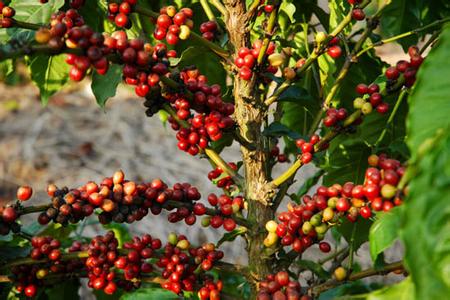Coffee training knowledge: coffee picking
The skin of ripe fruit is red. Because its shape and color are similar to cherries, ripe coffee fruits are called coffee cherries in many places. Under the bright red pericarp, the peel, pulp and a sweet sticky yellow substance wrap the coffee beans.

Normally, each fruit has two coffee beans, flat opposite to each other. There are also coffee trees that sometimes produce smaller fruits with only one coffee bean in it. this single coffee bean has a different name-round bean, single bean or Paula. It has no flat surface and is almost round. Because its quantity is very small and must be specially selected and collected together, the price is much higher than ordinary coffee beans. Many people think that the taste of round beans is particularly good, because its round bean shape can closely wrap the original taste of coffee in the beans, the taste is very strong, and is regarded as the best of coffee beans.
Most Arabica coffee beans mature from June to August and Robasta coffee beans from September to October. Therefore, although in some countries where the dry and wet seasons are not obvious, such as Colombia and Kenya, there are two flowering periods a year, that is, two harvests, but strictly speaking, there is only one harvest a year.
The harvest time of coffee varies from region to region. Regions north of the equator (such as Ethiopia and Central America) are generally harvested from September to November. South of the equator, such as Brazil and Zimbabwe, although the harvest can last until August, the main one is in April or May. Countries in the equatorial region, such as Uganda and Colombia, can harvest all year round, especially those plantations that can make good use of different elevations. As a result, there may be new coffee beans for most of the year.
Coffee fruits should be harvested immediately, and it is not easy to harvest coffee fruits at different ripening stages on the same tree. Generally speaking, it takes as long as 4-5 months to receive a full harvest from the initial harvest. If ripe and immature fruits are harvested at the same time, the quality of coffee will be reduced. Therefore, high-quality coffee is picked one by one by hand to maintain the perfect taste of the coffee.
Within a year, a typical Arabica coffee tree picks less than 5 kilograms of fruit and can be made into about 1 kilogram of coffee beans.
Important Notice :
前街咖啡 FrontStreet Coffee has moved to new addredd:
FrontStreet Coffee Address: 315,Donghua East Road,GuangZhou
Tel:020 38364473
- Prev

The wonderful use of coffee grounds
Coffee drinkers often have to face a lot of dregs left after brewing coffee, so it's a pity to dump it. A recent article published by the Coffee knowledge Network in the United States advises everyone to reuse their resources so that coffee grounds can become a good helper in life.
- Next

Effects of various substances in Water on Coffee
Choosing the right water can make coffee completely release its unique flavor, and every chemical in the water may react with coffee beans, thus affecting its taste and flavor. understanding the possible effects of some common chemicals in water on the taste of coffee is helpful for us to choose the right water.
Related
- Beginners will see the "Coffee pull flower" guide!
- What is the difference between ice blog purified milk and ordinary milk coffee?
- Why is the Philippines the largest producer of crops in Liberia?
- For coffee extraction, should the fine powder be retained?
- How does extracted espresso fill pressed powder? How much strength does it take to press the powder?
- How to make jasmine cold extract coffee? Is the jasmine + latte good?
- Will this little toy really make the coffee taste better? How does Lily Drip affect coffee extraction?
- Will the action of slapping the filter cup also affect coffee extraction?
- What's the difference between powder-to-water ratio and powder-to-liquid ratio?
- What is the Ethiopian local species? What does it have to do with Heirloom native species?

